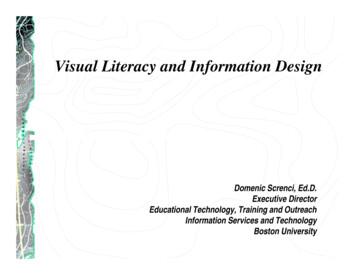20130528 Visual Literacy - Nuratnan.staff.telkomuniversity.ac.id
Visual LiteracyLoes Witteveen28/05/2013ImagesMedia do not work as simple channels ofcommunication, as ‘windows on the world’. Insteadmedia structure the very realities which they seem to‘describe’ or ‘stand in for’.1
ImagesImages are not only the image itself but it is also abouthow it is seen by particular spectators who look inparticular ways.Gillian Rose, Visual Methodologies (2007)Images2
ImagesWhat do we see? The image itself The audience The producerImagesThe audience:Visual literacy / visual competencyThe contextThe place; time, space(and issues of representation)3
Visual Literacy‘Farmers are reluctant laggards’Adoption & Diffusion Theories. Rogers‘Development workers confront dilemma's in their work in the Third world’Cross Cultural Communication(e.g. About Understanding by Andreas Fuglesang)Visual LiteracyTest de Alfabetización VisualTAV / ECOM 19914
RDC Media StudiesTest de Alfabetización Visual TAV / ECOM 1991Sombra 27 % negative answersSeñales 32 % negative answersVisual LiteracyTest de Alfabetización Visual TAV / ECOM 1991Sombra 35 % negative answersCorte 74 % negative answers5
Visual LiteracyTest de Alfabetización Visual TAV / ECOM 1991Interpretación 35 % negative answersVisual LiteracyTest de Alfabetización Visual TAV / ECOM 1991Esquema 91 negative answers6
Visual LiteracyTest de Alfabetización Visual TAV / ECOM 1991Esquema 88 % negative answers(3 personas no contestaron la pregunta)Visual LiteracyTest de Alfabetización Visual TAV / ECOM 19912 types of answers Turkeys as a sign of well being Unhygienic situations as reflected by the mud, filthiness etc.7
Visual LiteracyTest de Alfabetización Visual TAV / ECOM 1991Interpretación 12.5 % negative answers(sin mencionar la bomba de fumigacion)Visual LiteracyTest de Alfabetización Visual TAV / ECOM 1991Conclusion:Visual literacy is an issue of concern.The use of visual media requires to consider aspects of quality.Life cycles and other schematic representations relate to particulareducational settings where the schemes are learned.Researching visual literacy tends to ignore the role of the producer and theartists involved.8
Visual Literacy‘Farmers are reluctant laggards’Adoption & Diffusion Theories. Rogers‘Development workers confront dilemma's in their work inthe Third world’Cross Cultural Communication(e.g. About Understanding by Andreas Fuglesang)‘Media for agricultural extension and public healthpropaganda is not designer or produced professionally.A call for professionalism(e.g. Empresa de Communicaciones ECOM)Life cycle lies9
Life cycle liesLife cycle lies10
What do we see? – Semiotics / StructuralismThe image itselfSignifier: Compositional interpretation (The physical form)Signified: the object (A flower called Rose)Referent: ‘love’The audienceVisual literacy / visual competencyThe contextThe place; time, space(and issues of representation)The producerTechnologyRoles & responsibilitiesMedia ProductionProduction is about Technology Mimeographs or computer prints Celluloid Film or a mobile phone camera Amateur filming or broadcast qualityProduction is about Roles & Responsibilities The Commissioner The Producer The Designer The ArtistAnd what about the funding?11
A call for professionalismMedia for agricultural extension andpublic health propaganda should bedesigned and produced professionally.12
Visual Literacy Conclusion: Visual literacy is an issue of concern. The use of visual media requires to consider aspects of quality. Life cycles and other schematic representations relate to particular educational settings where the schemes are learned. Researching visual literacy tends to ignore the role of the producer and the artists involved.
Traditionally, Literacy means the ability to read and write. But there seems to be various types of literacy. Such as audiovisual literacy, print literacy, computer literacy, media literacy, web literacy, technical literacy, functional literacy, library literacy and information literacy etc. Nominal and active literacy too focuses on
Visual Literacy - The ability to understand, create and use visual images; to think and learn in terms of images . Visual Rhetoric: . Rarely a result of a single brilliant moment Result of User-Testing Series of Drafts and Revisions. Verbal - Visual Continuum Wileman's Typology Adapted from Moore, D.M. & Dwyer, F.M. (1994). Visual Literacy: A
course of visual literacy for in-service teachers was designed following ACRL Standards. In addition, a visual literacy test was created to assess in-service teachers’ visual literacy competency before and af-ter the course. The purpose of this pilot study was to examine the effects of the intervention applied to in-service teachers.
signed based on the ACRL Visual Literacy Competency Standards. The dif-ferences in the level of visual literacy were measured through a visual literacy test of 45 items made for this specific purpose. Differences between pretest and posttest were found after performing paired samples t-test on collected data.
Part VII. LIteracy 509 Chapter 16. A Primer on Literacy Assessment 511 Language Disorders and Literacy Problems 512 Emergent Literacy 514 Emergent Literacy Skill Acquisition 516 Assessment of Emergent Literacy Skills 520 Assessment of Reading and Writing 528 Integrated Language and Literacy Skill Assessment 536 Chapter Summary 537
the YCBA's longstanding visual literacy program, in which museum educators work closely with teachers to connect art to literacy instruction by broadening the defini-tion of literacy to include both visual and written "text" (Molomot, 2014). Figure 1. The PIE Model of Change here. Running head: VISUAL LITERACY, CREATIVITY, AND TEACHING .
the focus on visual observation does not tell the full story because written and printed texts can also be visually observed1. That is why Levie (1978) notes that literacy becomes visual literacy, not just because of the manner in which certain stimuli are received (visual perception), but also because of the
API An Application Programming Interface (API) is a set of routines, protocols, and tools for building applications. A Plex API in the Plex Developer Portal is a collection of related endpoints analogous to one or more Plex software modules. authorization code grant An OAuth 2.0 authentication flow where access is delegated to a client application.























